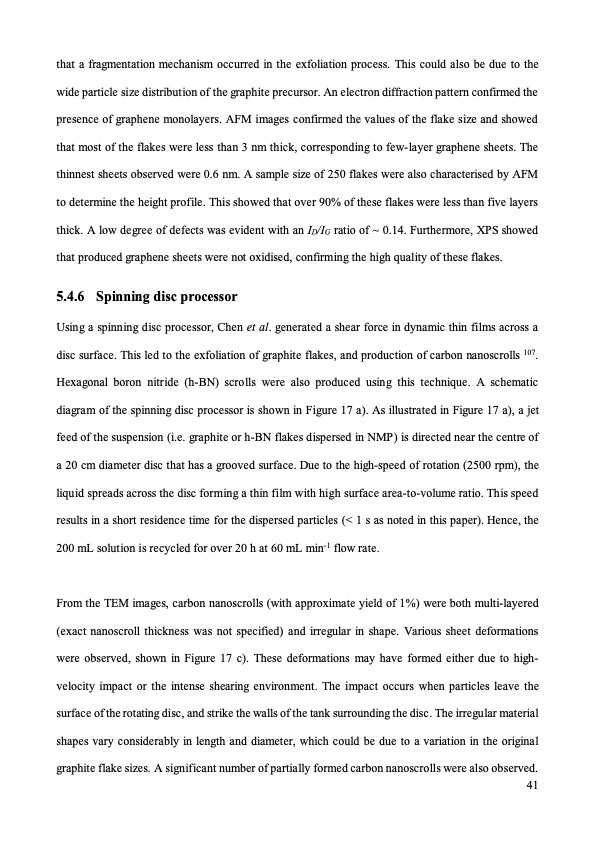PDF Publication Title:
Text from PDF Page: 041
that a fragmentation mechanism occurred in the exfoliation process. This could also be due to the wide particle size distribution of the graphite precursor. An electron diffraction pattern confirmed the presence of graphene monolayers. AFM images confirmed the values of the flake size and showed that most of the flakes were less than 3 nm thick, corresponding to few-layer graphene sheets. The thinnest sheets observed were 0.6 nm. A sample size of 250 flakes were also characterised by AFM to determine the height profile. This showed that over 90% of these flakes were less than five layers thick. A low degree of defects was evident with an ID/IG ratio of ~ 0.14. Furthermore, XPS showed that produced graphene sheets were not oxidised, confirming the high quality of these flakes. 5.4.6 Spinning disc processor Using a spinning disc processor, Chen et al. generated a shear force in dynamic thin films across a disc surface. This led to the exfoliation of graphite flakes, and production of carbon nanoscrolls 107. Hexagonal boron nitride (h-BN) scrolls were also produced using this technique. A schematic diagram of the spinning disc processor is shown in Figure 17 a). As illustrated in Figure 17 a), a jet feed of the suspension (i.e. graphite or h-BN flakes dispersed in NMP) is directed near the centre of a 20 cm diameter disc that has a grooved surface. Due to the high-speed of rotation (2500 rpm), the liquid spreads across the disc forming a thin film with high surface area-to-volume ratio. This speed results in a short residence time for the dispersed particles (< 1 s as noted in this paper). Hence, the 200 mL solution is recycled for over 20 h at 60 mL min-1 flow rate. From the TEM images, carbon nanoscrolls (with approximate yield of 1%) were both multi-layered (exact nanoscroll thickness was not specified) and irregular in shape. Various sheet deformations were observed, shown in Figure 17 c). These deformations may have formed either due to high- velocity impact or the intense shearing environment. The impact occurs when particles leave the surface of the rotating disc, and strike the walls of the tank surrounding the disc. The irregular material shapes vary considerably in length and diameter, which could be due to a variation in the original graphite flake sizes. A significant number of partially formed carbon nanoscrolls were also observed. 41PDF Image | graphene production via nonoxidizing liquid exfoliation

PDF Search Title:
graphene production via nonoxidizing liquid exfoliationOriginal File Name Searched:
Graphene-R2-review.pdfDIY PDF Search: Google It | Yahoo | Bing
Salgenx Redox Flow Battery Technology: Power up your energy storage game with Salgenx Salt Water Battery. With its advanced technology, the flow battery provides reliable, scalable, and sustainable energy storage for utility-scale projects. Upgrade to a Salgenx flow battery today and take control of your energy future.
CONTACT TEL: 608-238-6001 Email: greg@infinityturbine.com (Standard Web Page)